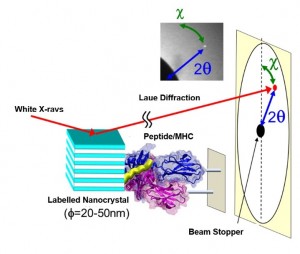Antigen complex single molecule observation with X-rays New autoimmune disease mechanism discovered

A research group led by Professor Yuji C. Sasaki at the Graduate School of Frontier Sciences, the University of Tokyo, and Associate Professor Haruo Kozono at the Research Institute for Biomedical Sciences, Tokyo University of Science, successfully observed the three-dimensional (3D) dynamic single-molecule internal motions of a peptide bound to major histocompatibility complex (MHC) for the first time. MHC is an important protein that controls acquired immune response, presenting pathogens that invade the body to immune cells. The group used the SPring-8 BL40XU beamline to discover how MHC binds to pathogen proteins (antigen peptides) and activates the immune system by observing the internal dynamics of single molecules.

© 2015 Yuji Sasaki.
Instrumental Arrangement of Diffracted X-ray Tracking for dynamical single molecule observations in immune systems.
Autoimmune antigen peptides that bind loosely to MHC molecules were known. However, how this loose interaction was related to the molecular mechanism of the immune response remained unknown experimentally. This research has shown that rotational movement of the complex is particularly active with respect to the axis of the antigen peptide, and that the antigen/MHC complex takes on a new structure which reacts with autoreactive T-cells.
The researchers examined the internal molecular dynamics of mouse MHC bound to a long peptide antigen (14 amino acid bases) and a short peptide antigen (10 amino acid bases). Using diffracted X-ray tracking (DXT), the only single-molecule observation technique that is both highly precise and extremely fast, and fluorescence anisotropy the group calculated the dynamics of each single molecule from observation of the movement of the molecular complex. The group discovered that when bound to MHC the short peptide antigen is more mobile that the long peptide antigen and takes a different structure.
The technique devised and demonstrated by the research group fuses single-molecule monitoring using a quantum beam with computational science. This approach is highly effective in the field of immunology where it will find many applications.
Press release (Japanese)
Paper
Haruo Kozono, Yufuku Matsushita, Naoki Ogawa, Yuko Kozono, Toshihiro Miyabe, Hiroshi Sekiguchi, Kouhei Ichiyanagi, Noriaki Okimoto Makoto Taiji, Osami Kanagawa, and Yuji C Sasaki,
“Single Molecular Motions of MHC Class II Rely on Bound Peptides”,
Biophysical Journal Online Edition: 2015/01/21 (Japan time), doi: 10.1016/j.bpj.2014.12.004.
Article link(Publication)
Links
Graduate School of Frontier Sciences
Department of Advanced Materials Science, Graduate School of Frontier Sciences






